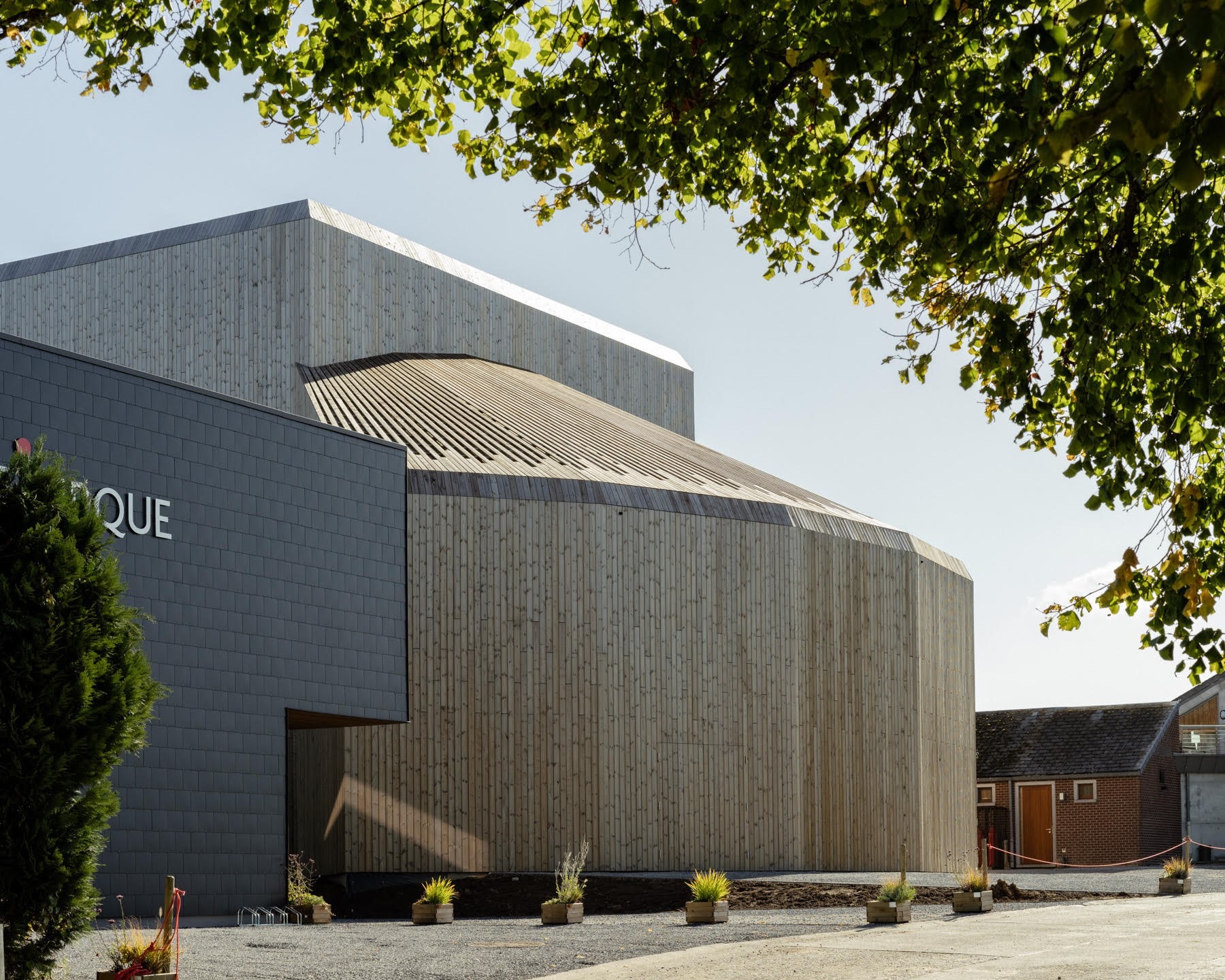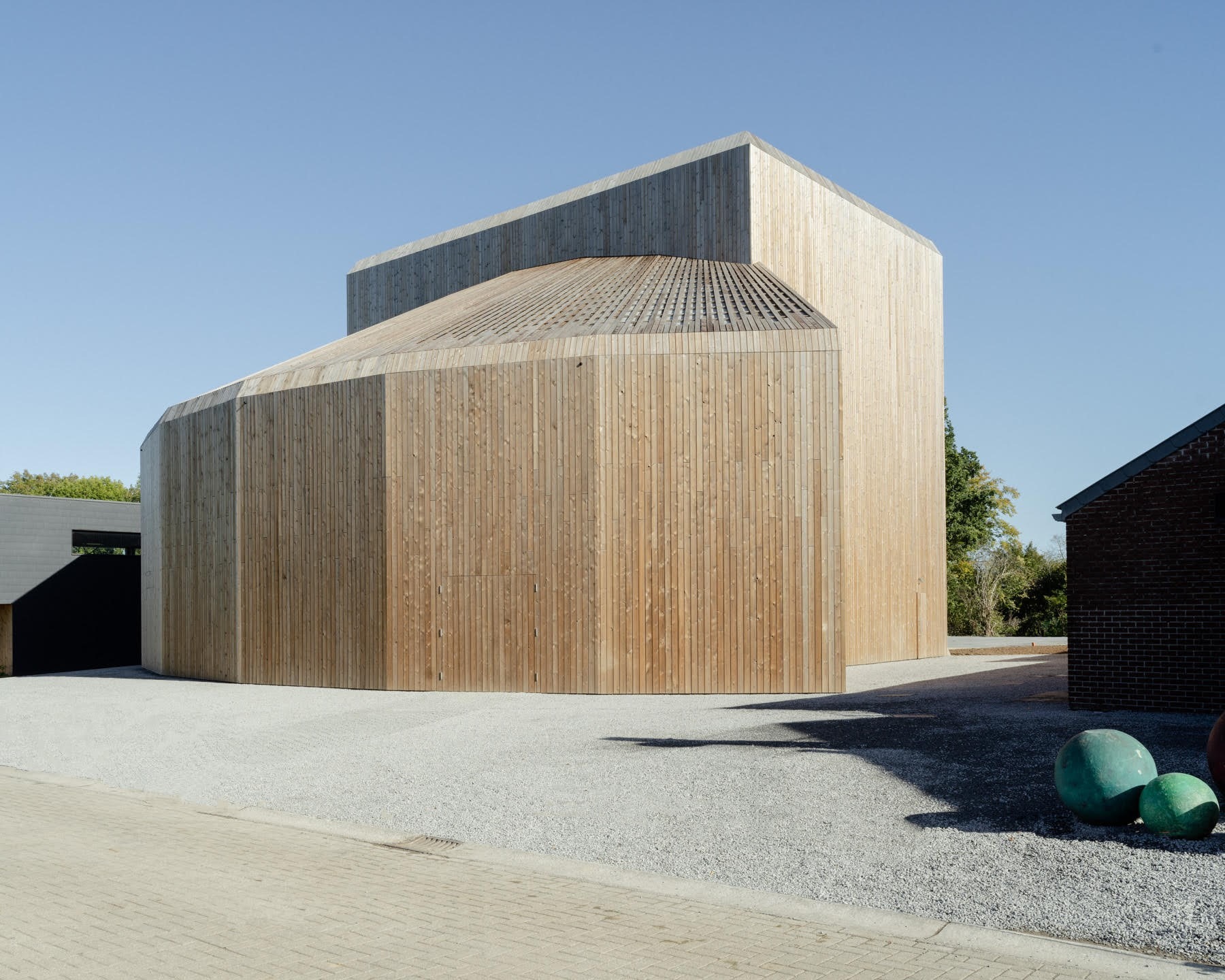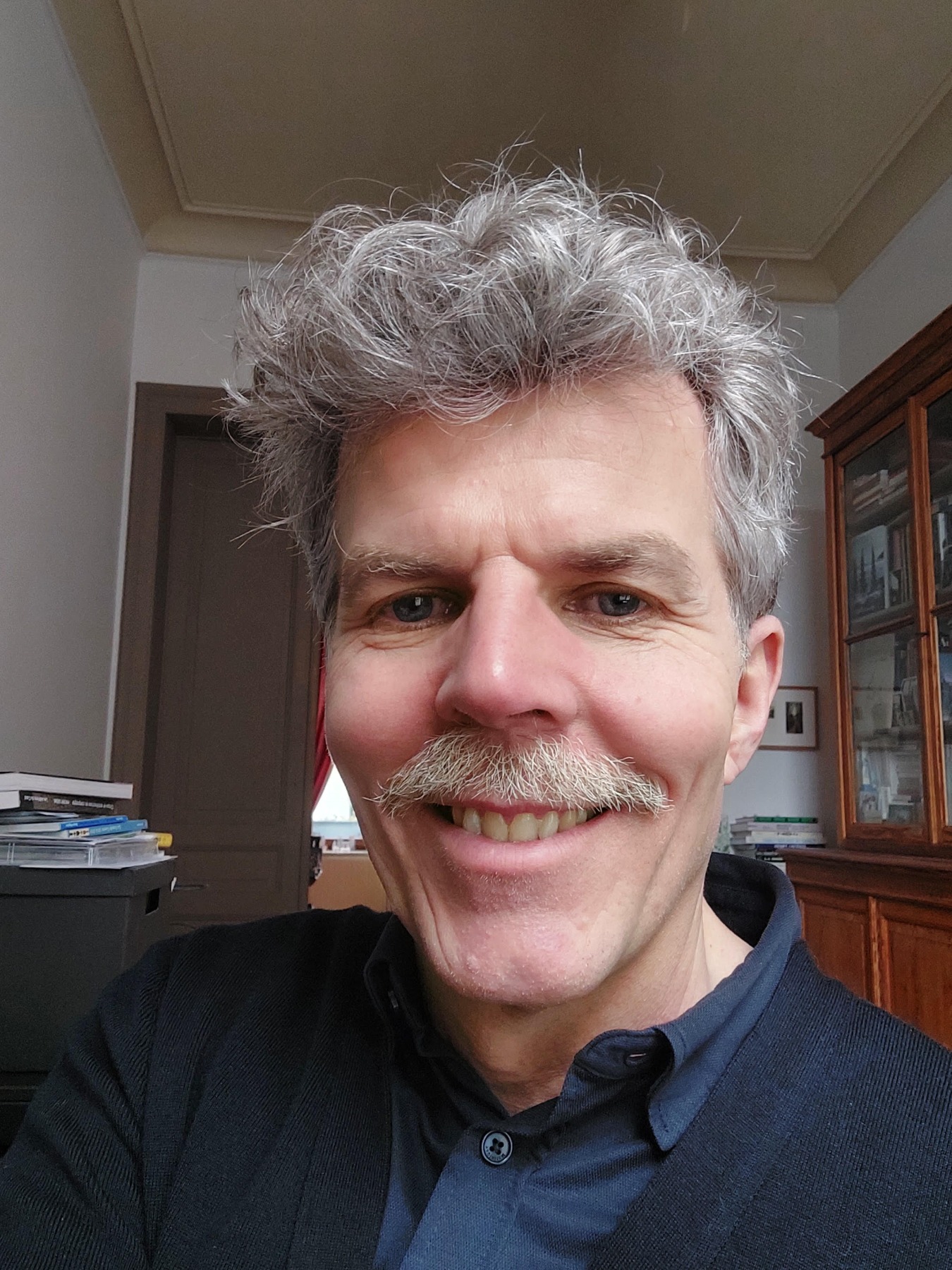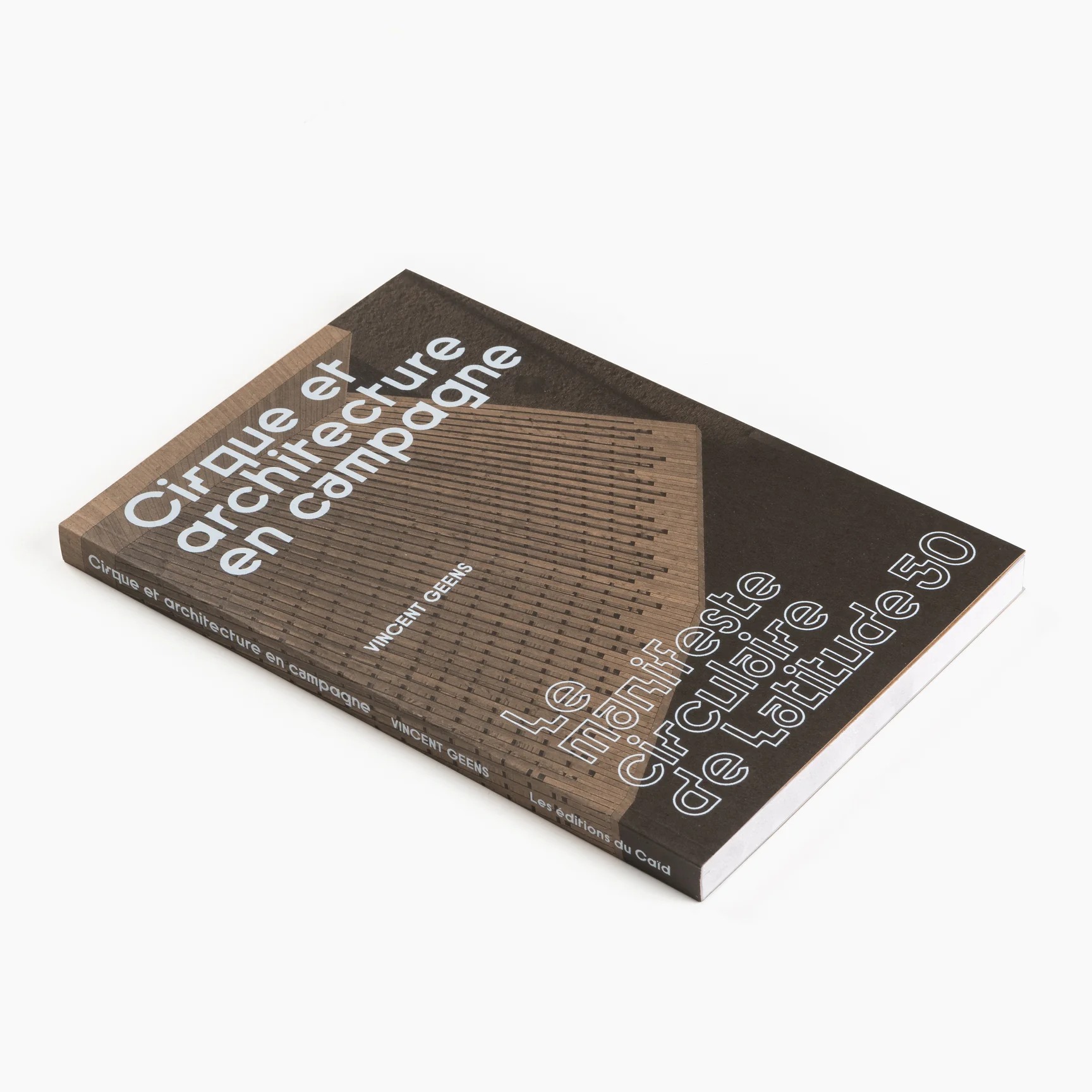
Unveiling the New Cirque de Latitude 50 in Belgium
A conversation with architecture researcher and author Vincent Geens
In 2022, a new architectural feature was drawn on the face of the southern Belgian city of Marchin; moreover, this addition developed there organically and naturally, and not as an indiscriminate urban injection. For several years now, Marchin has been home to Latitude 50, a circus and street art centre that has hosted a series of performances, co-organised street art festivals, and provides residency space for numerous circus companies and almost 200 artists who come to the city every year with their new programmes. This purposeful exercise in promoting the contemporary circus arts has resulted in a new high-quality cultural structure, namely, a new circus building. Designed by Matthieu Meunier (Atelier d’Architecture Meunier-Westrade), Latitude 50’s magical performances of circus and street art now take place within what looks like a half-circle big top made of timber. Among Europe’s growing family of new circus buildings, the structure in Marchin stands out with its quality wooden architecture developed in strict harmony with the location, its people, and the contemporary circus and its needs – the latter being arguably the most transformative genre of performing arts in the 21st century. Although this contemporary cultural building was created with reverence for traditional circus architecture, Meunier did not rigidly stick to a strict circular circumference but rather allowed the circular space to “open its arms wide open”.
In 2023, a 232-page book was published on the Latitude 50 circus project, titled Cirque et architecture en campagne (Circus and Architecture in the Countryside), by historian Vincent Geens. In the book, the author reveals the most surprising aspects of this unique cultural construction, answering fascinating questions such as – how was Latitude 50 able to develop a circus ecosystem and build a wooden circus and architectural village so coherently in just under 20 years, and moreover, in a rural community of just 5,000 inhabitants? The book captures the spirit of the place and serves as a factual archive of the construction of the circus building and the architectural village.
Vincent Geens will visit Latvia in March of this year, when the international architecture conference “New Circuses in Europe” (22.03.2024) will take place as part of the Riga Circus Grand Opening programme. At the conference, architecture and circus professionals from Latvia and abroad will present examples of new circus architecture as a tool for cultural democratisation and sustainable development, while Geens will invite the audience “to come along for a walk in the small village of circus architecture in the town of Marchin on the 50th parallel north.”
Latitude 50, a circus and street art centre. Photo: Matthieu Litt
Can you elaborate on the genesis of your book “Cirque et architecture en campagne”? Could you also provide some insight into how you structured its content?
Olivier Minet, director of Latitude 50, and Matthieu Meunier, the architect of the Cirque de Latitude 50, asked me to write a book to celebrate its inauguration. I was delighted to accept the commission, as I’ve been following the Latitude 50 project with interest since its inception. In 2003, I took part in the festival “Les Renc’arts de la FAR” in Marchin as a member of the Cie des Bonimenteurs, and its success was decisive in the creation of Latitude 50 a few months later. I remember how amazed I was when I discovered the beautiful village with circus tents and caravans. My book is based on this emotion and astonishment that was shared by many observers: how was Latitude 50 able to develop a circus ecosystem, build a wooden circus and architectural village so coherently in just under 20 years, and in a rural community of 5,000 inhabitants?
The book is divided into two parts. In the first, I tell the story of Latitude 50 and the journey of the people involved in the adventure. I describe the form of governance that made this incredible project possible. I then describe the design and construction of the wooden circus, the circus school, and the house for the artists in residence. I also give the floor to Jonas Hanssens, from the Architecture Unit of the French Community of Belgium, to present “Une structure des possibles” (Laboratoire Architecture), an artists’ residence that exemplifies an architecture that Pauline de La Boulaye poetically describes as “architecture saltimbanque” (travelling entertainer, street entertainer). Finally, I interviewed Franziska Trapp about our need for circuses and the new construction boom in permanent circuses in recent years.
Writing the book was a challenge, and the commission, as is often the case, was quickly exceeded... Although I am a historian, I underestimated the richness of the history of the circus and its architecture. I also immersed myself in the history of the street arts in French-speaking Belgium. I’ve put together my reading notes in the second part of the book, which is designed as a reference book.
This book is a plea for quality architecture that encourages boldness, participation, the use of wood, and the reuse of materials. An architecture that is firmly rooted in its territory and its community, and that meets the needs of the circus as it develops in Europe. This is the meaning of the book’s title, “Cirque et architecture en campagne”. In French, “en campagne” has a double meaning: it can mean both “in the countryside” and “campaigning”. The subtitle, “Le manifeste circulaire de Latitude 50”, announces the particular governance, the link to the circle, and the circulation of ideas and people.
Before we dive deeper into the book and the story of Latitude 50, how would you characterise the aesthetics of “Cirque et architecture en campagne”? Could you elaborate on the visual elements and the overall design choices that contribute to the book’s aesthetic appeal?
From the outset, we wanted to produce a book of narrative non-fiction, accessible to as many people as possible, and a book-object. As a graphic designer and photographer, Matthieu Litt took care of the book’s graphic design and the photographs of the circus and the surrounding buildings. For my part, I put together a wealth of iconography. The cover of the book is made of cardboard: the photograph of the circus roof is printed in black on this cardboard, to match the wood texture of the circus. The text on the cover is screen-printed in white. As an added touch, readers can cut out the model of the circus from the book: we’d like to see the model of the circus on the mantelpiece of many readers!
Being a historian and biographer, how did your research approach shape the storytelling in your book about Latitude 50?
The first target readers were the circus’s neighbours and local residents: we wanted to write a book that could be read on the counter of the bistro of Latitude 50. The second target group is the circus community, which isn’t always close to the world of architecture. The third is the community of architects, construction companies and public authorities concerned with the role that culture can play in regional development. The book reflects Latitude 50’s desire to bring people together.
It is not, therefore, a book of architectural criticism or theory: some sections may seem too detailed or explanatory for architects. The book conveys the spirit of the place and is also an archive of the construction of the Cirque and its village of architecture. During my research, I realised that there was very little information on the permanent circuses built in Belgium in the second half of the 19th century and at the beginning of the 20th century. Nor was there any overview of the development of the circus and street arts since the late 1970s. I missed that. In writing this book, I set out to prepare an “archive of the future”. The book publishes the complete plans of the circus. The specification sheet details the partners and funding for the construction. I wanted the book to reflect the context of creation and to be a snapshot of Latitude 50 in October 2023.
The writing of the book is being extended by a season that I’m coordinating for Latitude 50 and its partners, entitled “Nouveaux cirques, nouvelles architectures”, the aim of which is to bring together worlds that don’t often meet: circus artists and architects. This season will culminate in an international colloquium “New Circus. New Architectures?” organised in November 2024 by Franziska Trapp (Université Libre de Bruxelles) and Jan Lazardzig (Freie Universität Berlin).
Latitude 50, a circus and street art centre. Photo: Matthieu Litt
What led you to focus on the specific aspects within the circus arts and architecture realms that became central themes in your book?
A visitor to the circus made a provocative remark that stimulated me. While visiting the site, which was still under construction, he said: “But this isn’t a circus, it’s a theatre!” I immediately set about finding out: what is a circus? What are its characteristics? What type of performance space does Cirque de Latitude 50 refer to? And if it’s a circus built entirely of wood, how does it relate to the wooden circus-buildings of yesteryear? And more pertinently still, how can it be included in the history of all-wood theatres, of “théâtre sorti du bois” (theater out of the woods) to which Yann Rocher devoted his doctoral thesis? The investigation was fascinating, and confirmed that this was indeed an all-wood circus, with an original typological structure.
Your book stresses the importance of quality architecture, boldness, community involvement, and sustainability. How did you structure these principles throughout your book?
I began by charting the strict chronology of Latitude 50’s development, and in so doing, I realised the extent to which its governance has been established little by little, over the years, in an empirical, almost intuitive way. The ideas were generated by the project: to emphasise their importance, I have chosen the form of a short treatise on governance, which strings together intuitions rather than articles, following the chronology as closely as possible. The text is lighter and easier to read.
The architectural approach here is circular. First of all, it is part of a sustainable and circular economy favouring local wood, local craftsmen, and energy savings during both construction and running of the site. It also favours the circulation of ideas, the link to history and to the people who need the circus.
Looking back at creating your book, were there any particular moments or revelations that significantly influenced its direction and final content?
Yes, there were several revelations. It was the first time I’d written a book on the architecture and history of the circus. Reading Christian Dupavillon’s book opened my eyes to the long and fascinating history of circus architecture. My meeting with Chantal Dassonville, who for many years headed the Architecture Unit of the French Community of Belgium, was decisive. She drew my attention to the Davos Declaration and its eight criteria for assessing the cultural quality of buildings in Europe. Among these criteria, she emphasised the importance of governance. I was interested in the governance of the Commune of Marchin and Latitude 50. The way they have listened to the needs of the circus community, their ongoing commitment, and the process they have put in place are exemplary. From the outset, they brought different skills and different points of view to the table to assess the quality of the project.
I discovered Yann Rocher’s research on all-wood theatres, published in “Les Cahiers de l’Ibois” in Lausanne, a little late – but fortunately! Yann Rocher has identified nearly 700 all-wood theatres and circuses in the history and present-day world of architecture, a whole forest of models through which we are happy to wander with him. Concerning the wooden circus, he looks for its ancestors in tents, theatres and barns. He examines the extent to which its structure makes the crossing a spectacle, and its envelope, through the transition from canvas to panel, a guarantee of sustainability, comfort and conviviality. He notes the special relationship that all-wood circuses have with the environment and the landscape. He underlines the ambiguity of the big top form when it takes root, when the ephemeral becomes permanent. This perpetuation of the ephemeral and its supposed fragility is a serious attempt to break free from an architecture that today is generally too rigid. He observes how today’s architects are postulating other models, inventing new forms. As here, in Marchin, where the circle takes a tangent: if the circus is the place of the collective gathered in or around the figure of the circle, Matthieu Meunier is not satisfied with a limited, perfectly circumscribed space. He has made a centre fit without forcing himself to centre everything. He has invented a form that allows liberation, that opens the circle, that nourishes creation. He let in natural light through a zenithal window and a wide shutter opened the stage towards the horizon. The stage is then doubled in size and becomes a clearing.
With Latitude 50’s role in a small rural area and its impact on fostering creativity, do you see it as a model or, let’s say, a blueprint for larger societal and cultural structures?
Yes, Marchin has chosen culture as a lever for regional development. Alongside Latitude 50, Oyou, the cultural centre with its famous Photography Biennial, and Devenirs, a social and professional integration centre where scenography elements are created for artists in residence at Latitude 50, are also flourishing. Over 30 cultural jobs have been created in a rural community, not to mention the economic support that these structures provide to artists, craftspeople and producers. Marchin brings together energies and forges solid partnerships at all levels: local, regional, national and international. What happens in Marchin resonates elsewhere in the world, and that’s very inspiring.
How do you envision the future evolution of Latitude 50 and similar artistic hubs, both in terms of architectural innovation and their role in nurturing creativity and cultural participation?
In my opinion, Latitude 50 will remain a leading architectural laboratory and arts centre. It’s in its genes: the spirit of the place is embodied in the whole team... and in the Cirque! A spirit of openness, benevolence and exchange. At Latitude 50, nothing is done on the spur of the moment; it’s done after discussion, with a clear understanding of the issues and needs, and a shared objective: to serve the circus and street arts, the artists and the community.
Now, I would like to turn our focus to some of the architectural details of the building. Could you share the sustainable or eco-friendly design elements that were incorporated into the construction of the new Cirque de Latitude 50?
The decision to build the entire circus out of wood is the key to its sustainable design. The building incorporates bio-sourced materials that are easy to dismantle and recycle. The construction is accompanied by attention to the water cycle and the sparing use of soil: it resembles a sculpture that a giant’s hand has placed in a meadow. The building is wrapped in high-performance insulation and equipped with innovative technologies. It seeks to be energy self-sufficient in its day-to-day use, thanks to an efficient heating system and solar panels on the roof.
Considering the dynamic nature of street art and circus performances, how will the new building balance functionality and flexibility in its architectural design to allow for creative adaptability within the space?
I put a similar question to Franziska Trapp, who has been travelling the circus world for years. Her answer is eloquent. For her (and I fully agree), “the Cirque de Latitude 50 symbolises the hybridity of the circus, the space between several art forms. It combines the circus (the shell that holds the benches, the height and the hooks), the theatre (the stage space) and the street (the open stage at the back). The language of today’s circus is also a hybrid between the language of dance, the relationship to the apparatus, the object, the material, the plastic arts, the theatre... We can also see the influence of climbing and sailing techniques. This building allows us to create and present a multitude of forms, and to welcome a wide range of companies. It gives a great deal of freedom to companies wishing to experiment with hybrid forms or explore new avenues.”
What aspects do you believe future circus buildings need to incorporate to remain adaptable to changing artistic expressions and entertainment preferences?
Circuses are the reflection of visions in a clearly defined context in time: that’s also where their beauty lies, don’t you think? The builders obviously hope that their visions will meet the expectations of artists and audiences for a long time to come.
How do you see circus buildings evolving in terms of their architectural significance and their contribution to cultural heritage in the upcoming decades?
I would argue that this architecture should be nourished by a sense of community, the pleasures of exchange, the taste for risk, the importance of the body and the sensitive world, attention to others, and the constant renewal that characterises the circus arts.
As the re-opening of the Riga Circus, one of the oldest circus buildings in Europe, approaches, I would like to ask: How can we strike a balance between preserving the historical significance of these historic circus buildings and ensuring their continued functional relevance in today’s architectural landscape?
It’s difficult to give an overall answer to your question. Each building is unique, and not necessarily part of a well-established circus dynamic. But all these circuses deserve to have artists, operators and architects involved in thinking about how they can be adapted to today’s circus requirements (if not reallocated). In local and collaborative architecture laboratories, it seems to me that we can envisage functional reconfigurations and the construction of modules that can be adapted to the vast old circuses.

How do contemporary architectural designs for circus buildings incorporate or reinterpret historical elements while embracing modern functionality and aesthetics?
This is the interest of circus architecture, which balances between tradition and innovation, and which draws on its references to renew itself!



